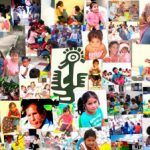Profiling Tepehua
By Moonyeen King

Some economists argue that four decades from now, Mexico will be among the five biggest economies in the world, along with China, USA, Japan and India. Meanwhile, back in the barrio, borders are being formed between the poverty stricken. One might think the shared poverty would bring the small barrios together; instead it splits them apart. Territorial rights take over, distrust and gangs form, even among the children. The pecking order of poverty is in place, and the dark skin, the less educated and the poorest of the poor are at the bottom.
One of this author’s column’s on racism was not well-received by the older Mexicans, who refuse to admit its existence, but willingly admit it is more to do with class. Is there a difference? The younger generation admits and acknowledges there is racism, and that skin color matters.
In May, 2014, Mexico City news paper “La Jornada” headlined an article that said that “Racism is so well established in Mexico, it is hidden.” You may ask, since everyone in Mexico is Mestizo, how can there be racism?
This takes us back to the Spaniards who brought their African slaves to Mexico with them, and left them all behind when the Spaniards were defeated. Colonies of Africans formed, keeping to themselves at first because of language and education. Then intermarrying with the local indigenous, and as migration took place they also intermarried with the Spaniard/Indigenous mix, not to mention the French, so hence Mestizo.
After the revolution, Mexico emphasized their Indigenous and European past activity, passively eliminating its African one from popular consciousness. When Africans mixed with the Spanish and the Indigenous, it created an elaborate cast system based on heritage. Mestizo, Mulatto, Zambaigo, and Castizo which was considered white. Information on each to be found in Wikipedia.
As there is so much information on this subject, the reader is urged to Google Afro-Mexican, fascinating reading in Wikipedia, and other publications.
The mixed heritage in the barrio of Tepehua is quite clear, from the Spanish, French, Indigenous to the African, and the mixture of the cultures. If they could all recognize their heritage with pride, how rich the tapestry would be. It is said one day the world will all be a darker shade of pale. This is inevitable. From the Stone Age peoples have migrated; it used to take lifetimes for generations to move from one spot to another on foot. Now, migration is an airport away, so the rapid changes in societies around the world are very visible. It can be seen in one generation.
Sadly it also promotes racial discrimination, because it is a sudden happening and doesn’t give people time to understand and integrate. But that day is surely coming when we are all equal under the sun.
Moonyeen King.
President of the Board for Tepehua.
- April 2024 – Issue - March 31, 2024
- April 2024 – Articles - March 31, 2024
- April 2024 - March 31, 2024








